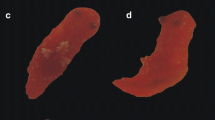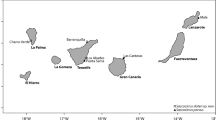Abstract
We describe a new chaetognath species, Spadella valsalinae sp. nov., discovered and collected in the Northern Adriatic Sea (Pula, Croatia). S. valsalinae sp. nov. is a benthic species living at 10–12 m depth attached to the surface of roughly sorted sediment. The cosmopolitan, seagrass-inhabiting species Spadella cephaloptera Busch, 1851 was also recorded in the sampling area. Characters from comparative morphology and molecular phylogeny based on SSU rRNA (18S) sequences support a sister group relationship of S. valsalinae sp. nov. with Spadella lainezi and Spadella ledoyeri. Thus, S. valsalinae sp. nov. represents the first member in the ‘Spadella ledoyeri' complex that is not a troglophilic species. By comparison with the various known European Spadella species, we defined a specific set of morphological characters, such as the number, shape and mutual proportions of the teeth, the lateral fins, the corona ciliata, the seminal vesicles, as well as the presence of ventral adhesive papillae, which is unique for S. valsalinae sp. nov. The biogeography of Spadella members in the Mediterranean Sea and the Eastern Atlantic as well as their phylogenetic relationships are discussed, with the focus on processes of neo-endemism in an epeiric area like, for instance, the Northern Adriatic Sea.






Similar content being viewed by others
References
Artegiani, A., Paschini, E., Russo, A., Bregant, D., Raicich, F., & Pinardi, N. (1997). The Adriatic Sea general circulation. Part I: Air-sea interactions and water mass structure. Journal of Physical Oceanography, 27, 1492–1514.
Băcescu, M. (1985). The effects of the geological and physico-chemical factors on the distribution of marine plants and animals in the Mediterranean Sea. In M. Moraitou-Apostolopoulou & V. Kiortsis (Eds.), Mediterranean marine ecosystems. NATO Conference Series I. Ecology. Vol. 8 (pp. 195–215). New York: Plenum.
Ben Rais Lasram, F., Guilhaumon, F., Albouy, C., Somot, S., Thuiller, W., & Mouillot, D. (2010). The Mediterranean Sea as a ‘cul-de-sac’ for endemic fishes facing climate change. Global Change Biology, 16, 3233–3245.
Bianchi, C. N., & Morri, C. (2000). Marine biodiversity of the Mediterranean Sea: situation, problems and prospects for future research. Marine Pollution Bulletin, 40, 367–376.
Bone, Q., Kapp, H., & Pierrot-Bults, A. C. (1991). The biology of chaetognaths. Oxford, New York: Oxford University Press.
Boudouresque, C. F. (2004). Marine biodiversity in the mediterranean status of species, populations and communities. Scientific Reports of Port-Cros National Park, 20, 97–146.
Casanova, J.-P. (1986). Spadella ledoyeri, un chaetognathe nouveau de la grotte sous-marine obscure des Trémies (Calanques de Cassis). Rapport de la Commission Mer Méditerranée, 30, 196–197.
Casanova, J.-P. (1987). Deux chaetognathes benthiques nouveaux du genre Spadella des parages de Gibraltar remarques phylogénétiques. Bulletin du Muséum d’Histoire Naturelle Paris, 4 e série (section A, n° 2), 9, 375–390.
Casanova, J.-P. (1992). Les chaetognathes cavernicoles de la Méditerranée nord-occidentale: adaptations et spéciation, comparaison avec l’Atlantique. Bulletin de l’Institut Océanographique de Monaco (spécial issue), 9, 83–100.
Casanova, J.-P., & Moreau, X. (2004). A new Spadella (Chaetognatha) from shallow waters of La Graciosa (Lanzarote, Canary Islands). Biogeographical remarks. Cahiers de Biologie Marine, 45, 373–379.
Casanova, J.-P., & Perez, Y. (2000). A dwarf Spadella (Chaetognatha) from Bora Bay (Miyako Island, Japan). Cahiers de Biologie Marine, 41, 137–141.
Casanova, J.-P., Hernández, F., & Jiménez, S. (2006). Spadella lainezi n. sp., the first cave chaetognath from the eastern Atlantic Ocean. Vieraea (Santa Cruz de Tenerife), 34, 17–24.
Coll, M, Piroddi, C., Steenbeek, J., Kaschner, K., Ben Rais Lasram, F., Aguzzi, J., et al. (2010). The biodiversity of the Mediterranean Sea: estimates, patterns, and threats. PLoS one, 5(8), e11842, 36 p.
Emig, C. C., & Geistdoerfer, P. (2004). The Mediterranean deep-sea fauna: historical evolution, bathymetric variations and geographical changes. Carnets de Géologie (Notebooks on Geology) 2004/01 (CG2004_A01_CCE-PG).
Fredj, G., Bellan-Santini, D., & Meinardi, M. (1992). État des connaissances sur la faune marine méditerranéenne. Bulletin de l’Institut Océanographique de Monaco (numéro spécial), 9, 133–145.
Ghirardelli, E., & Gamulin, T. (2004). Fauna d’Italia (Vol XXXIX). Chaetognatha. Calderini: Bologna.
Giaccone, G. (2003). Biodiversity of the Mediterranean Sea: an introductory speech to the Marine Algae Symposium. Bocconea Palermo, 16, 182–192.
Guindon, S., & Gascuel, O. (2003). A simple, fast, and accurate algorithm to estimate large phylogenies by maximum likelihood. Systematic Biology, 52, 696–704.
Hsü, K. J. (1974). The Miocene desiccation of the Mediterranean and its climatical and zoogeographical implications. Naturwissenschaften, 61, 137–142.
Hsü, K. J., Ryan, W. B. F., & Cita, M. B. (1973). Late Miocene desiccation of the Mediterranean. Nature, 242, 240.
Huelsenbeck, J. P., & Ronquist, F. (2001). MRBAYES. Bayesian inference of phylogenetic trees. Bioinformatics, 17, 754–755.
John, C. C. (1933). Habits, structure, and development of Spadella cephaloptera. Journal of Cell Science (formely Quaterly Journal of Microscopical Science), 75, 625–696.
Kapp, H., & Giere, O. (2005). Spadella interstitialis sp. nov., a meiobenthic chaetognath from Mediterranean calcareous sands. Meiofauna Marina, 14, 109–114.
Klein, B., & Roether, W. (2002). 5. Ozeanographie und Wasserhaushalt. In Hofrichter, R (Ed.). Das Mittelmeer – Fauna, Flora, Ökologie. Band I: Allgemeiner Teil. (pp. 258–287). Heidelberg: Spektrum Akademischer Verlag.
Marlétaz, F., Gilles, A., Caubit, X., Perez, Y., Dossat, C., Samain, S., Gyapay, G., Wincker, P., & Le Parco, Y. (2008). Chaetognath transcriptome reveals ancestral and unique features among bilaterians. Genome Biology, 9(6), R94.
Müller, C. H. G., & Schubart, C. D. (2007). Insights into the Crustacea of the Adriatic Sea. Observations from four sampling locations along the Croation coast. Rostocker Meeresbiologische Beiträge, 18, 117–135.
Papillon, D., Perez, Y., Caubit, X., & Le Parco, Y. (2006). Systematics of Chaetognatha under the light of molecular data, using duplicated ribosomal 18S DNA sequences. Molecular Phylogenetics and Evolution, 38, 621–634.
Por, F. D. (1978). Lessepsian migration. The influx of Red Sea biota into the Mediterranean by way of the Suez Canal. Ecological Studies 23 (p. 228 p). Berlin: Springer.
Por, F. D., & Dimentman, C. (2006). Mare nostrum. Neogene and anthropic natural history of the Mediterranean basin, with emphasis on the Levant. Sofia: Pensoft.
Scaccini, A. A., & Ghirardelli, E. (1941). I chetognati del Mare Adriatico presso Rovigno. Note dell’Instituto Italo-Germanico di Biologia Marina de Rovigno d’Istria, 22, 3–17.
Števčić, Z. (2002). New observations on the Adriatic decapod fauna (years 1990–2000). International Journal of Crustacean Research, 75, 643–647.
Telford, M. J., & Holland, P. W. H. (1997). Evolution of 28S ribosomal DNA in chaetognaths, duplicate genes and molecular phylogeny. Journal of Molecular Evolution, 44, 135–144.
Tortonese, E. (1985). Distribution and ecology of endemic elements in the Mediterranean fauna (fishes and echinoderms). In M. Moraitou-Apostolopoulou & V. Kiortsis (Eds.), Mediterranean marine ecosystems. NATO Conference Series I. Ecology. Vol. 8 (pp. 57–83). Ney York, London: Plenum Press.
Travizi, A., & Vidaković, J. (1997). Nematofauna in the Adriatic Sea: review and checklist of free-living nematode species. Helgoland Marine Research (Helgoländer Meeresuntersuchungen), 51, 503–519.
Vermeij, G. J. (1978). Biogeography and adaptation (p. 332). Cambridge: Harvard University Press.
Zavatarelli, M., Raicich, F., Bregant, D., Russo, A., & Artegiani, A. (1998). Climatological biogeochemical characteristics of the Adriatic Sea. Journal of Marine Systems, 18, 227–263.
Zenetos, A., Siouku-Frangou, I., Gotsis-Skretas, O., & Groom, S. (2002). The Mediterranean Sea – blue oxygen-rich, nutrient-poor waters. European Environment Agencies, 22 p.
Acknowledgements
We are grateful to Dr. Rabea Schlüter for providing time at the scanning electron microscope in her laboratory for electron microscopy (University of Greifswald). We also thank our various dive partners working at the Meeresschule in Pula who accompanied C.W. and C.M. several times to the type locality of Spadella valsalinae sp. nov. in the Bay of Valsaline (Croatia). We also appreciate the technical assistance of Mrs. Erika Becker and Dipl. Biol. Matthes Kenning (both University of Greifswald). Prof. Steffen Harzsch (University of Greifswald) gave fruitful linguistic comments. Prof. Roland R. Melzer (Bavarian State Zoological Collection, Munich) and two referees provided numerous, fruitful comments that helped us to improve the quality and consistency of our manuscript. This study was supported by grant HA 2540/7-2 in the DFG focus program “Metazoan Deep Phylogeny” (SP 1174).
Author information
Authors and Affiliations
Corresponding author
Additional information
Carsten H.G. Müller and Yvan Perez share senior authorship
Electronic supplementary material
Below is the link to the electronic supplementary material.
ESM 1
(DOC 44 kb)
(MP4 265077 kb)
(MP4 25588 kb)
Rights and permissions
About this article
Cite this article
Winkelmann, C., Gasmi, S., Gretschel, G. et al. Description of Spadella valsalinae sp. nov., a neo-endemic benthic chaetognath from Northern Adriatic Sea (Croatia) with remarks on its morphology, phylogeny and biogeography. Org Divers Evol 13, 189–202 (2013). https://doi.org/10.1007/s13127-012-0108-0
Received:
Accepted:
Published:
Issue Date:
DOI: https://doi.org/10.1007/s13127-012-0108-0




